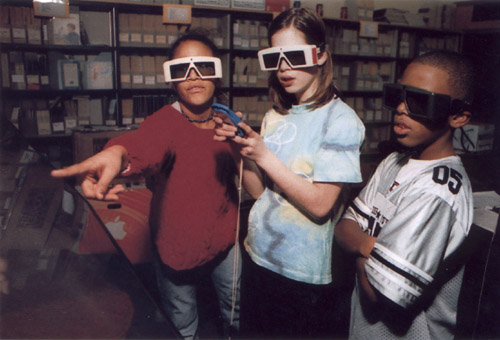


February 16, 2000
BY CARLOS SADOVI SUBURBAN REPORTER
Imagine donning a pair of glasses and being transported to an unchartered land as your teacher discusses scientific research techniques.
Or being able to handle a pulsating human heart to learn about biology, or looking down at the Earth from a spaceship to grasp geography in a three-dimensional way.
While that might be the stuff of science fiction for most people, it's reality for students at Oak Park's Lincoln School.
The school is the first elementary school in the country to house a semi-permanent "virtual reality" unit.
"It's cool that we can do schoolwork, and it's not like we have to just write down on paper," said Felicia Bridgers, a sixth-grader, as she worked with other students on an assignment. "It's awesome."
The west suburban school is being used as a test site by University of Illinois at Chicago researchers, who are studying whether virtual reality technology can be used effectively to teach students school subjects.
The project is funded by the National Science Foundation.
It calls for first- through sixth-grade teachers to integrate virtual reality into their teaching plans over the next three years, said computer science assistant professors Tom Moher and Andy Johnson, who are heading the project. They are working with Stellan Ohlsson, a professor of psychology.
While they've used virtual reality temporarily in the past, the researchers' aim is to see if students will learn material more effectively using the technique on a permanent basis.
"We want to answer the question: Is it useful for conceptual learning? Does it help you learn?" Johnson said. "We thought, let's go after the kids when they are most perceptive to it."
Over the course of the project, all students in the school will get a chance to use the virtual reality computer, which is housed in a storage area near the school's library.
The computer works by projecting onto a large screen. With the aid of special glasses, images become three-dimensional and can be manipulated by students with a hand-held control.
The researchers hope that students eventually will get used to the novelty and think of virtual reality as another teaching tool, like books and films, Moher said.
"We're working very hard to work against the hype. We want to get to the point where kids are kind of bored with the technology itself," said Moher.
Marilyn Rothstein, who has taught for 15 years, knows virtual reality is in the future for teaching.
"Using virtual reality, the children are experiencing it, and it keeps their attention," said Rothstein. "It's an interactive approach. It keeps them focused through their own experiences."